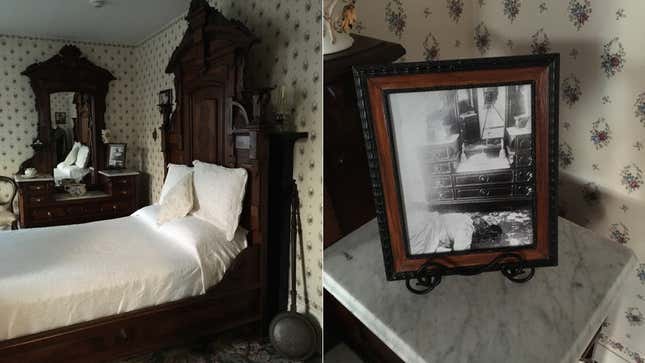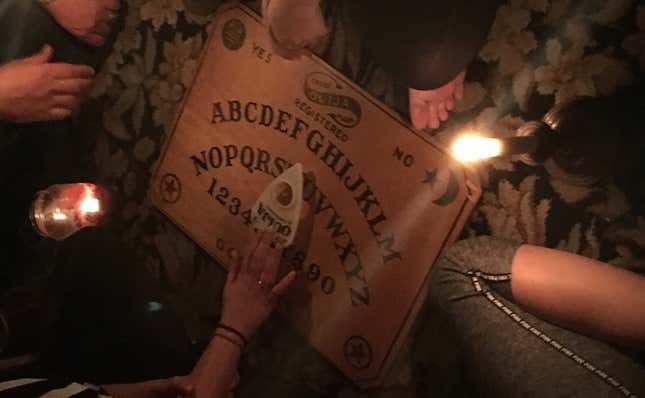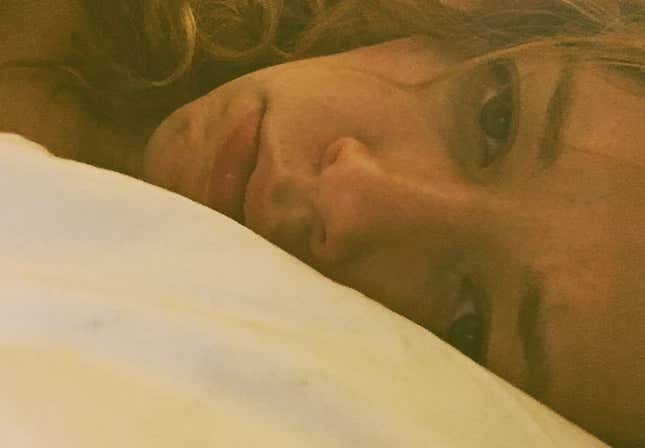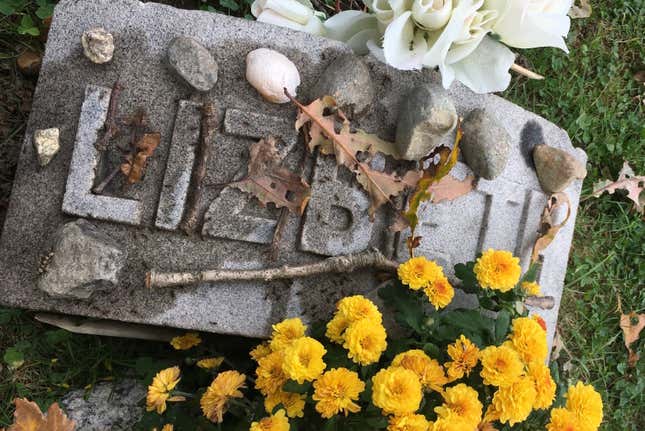My Sleepless Night Alone at the Allegedly Haunted Lizzie Borden B&B
In Depth

I’m covered in flop sweat, my hands are shaking, and an itchy flush in my cheeks hints that tears are just moments away. While the Lizzie Borden Bed and Breakfast is a mere 20 miles from the Providence Amtrak station, I’ve been lost for 30 minutes and it feels like a bad sign.
Nestled away in Fall River, Massachusetts, the notorious site of two 19th-century murders will be my home for a night in October. (My editor thinks it will be funny if I stay there alone. I think it will be funny if I haunt her forever after I’m murdered by ghosts.) My journey there reminds me—through some combination of Google Maps, my own inexperience driving in rush hour traffic, and evil spirits, presumably—that terror is already close at hand. By the time I reach the Lizzie Borden house, my nerves are shot.
“I’m guessing you’re Madeleine,” says the man who checks me in after I go to the wrong door and ring the wrong bell twice. Despite his guesswork, he—with a backwards baseball hat and lip ring—comes off more like Fred Durst than Wadsworth from Clue (and the former is certainly scarier). He knows who I am not through premonition, but because I’m the last guest to arrive and the only guest who’s come without company.
Painted a somber dark green with black shutters, the Lizzie Borden Bed and Breakfast looms on Second Street, several blocks from the Taunton River and just off I-195. Its immediate surroundings include the Fall River Justice Center, a housing complex called Borden Place, and blocks of shabby houses, which are occasionally interrupted by crumbling Victorian mansions—glorious and skeletal reminders of a time when Fall River was a booming mill town.

The Lizzie Borden Bed and Breakfast, located at 230 2nd St in Fall River, Mass.
The Borden house was built in 1845 by Charles C. Trafton and gained infamy just shy of 50 years later when, on August 4, 1892, the home’s owner—a wealthy property developer named Andrew Borden—was discovered dead on his parlor sofa, his face pulverized by the blade of a hatchet. The corpse of his wife Abby—also having taken its fair share of hatchet blows—was found in an upstairs bedroom moments later. As the famous jump rope rhyme will tell you, the case’s primary suspect was Andrew’s 32-year-old daughter (and Abby’s stepdaughter) Lizzie.
The scandal was instant. Not only were the Borden murders grisly and violent, but there was also the added twist—unfathomable in the 19th century—that the murderer might be a woman, and a wealthy one at that. Lizzie’s trial received media attention from all over the world.
But the investigation into the Bordens’ death was so hapless (typical in the 19th century) and the evidence was so limited that the jury never came close to convicting Lizzie of murder. No one ever found a weapon; blood from the victims was never discovered on Lizzie’s body nor any of her clothing (she was, however, caught suspiciously burning a dress weeks into the inquisition); there were no witnesses—or at least none willing to come forward—who saw her commit the crime. The other suspects—Lizzie’s older sister Emma, her uncle John Morse, the family’s maid Bridget Sullivan, and a mysterious drifter—were never seriously considered, because they all had alibis. (Or, in the case of the drifter, his existence was never proven at all.)
The crime is still unsolved, and if the several Lizzie Borden movies and TV shows are any indication, people remain just as fascinated in the case today as they did in 1892.
I’m worried that Tim will think I’m creepy for showing up alone to a house like this, but my fears are unfounded. The Lizzie Borden Bed and Breakfast—upsetting as some might find it—is a place where people come to revel in creepiness. Graphic crime scene photos are prominently displayed in the rooms, signs jokingly tell you to “watch your head,” and the dining room china cabinet contains two model skulls that show exactly how the Bordens were bludgeoned.

Left: The John V. Morse room and site of Abby Borden’s death. Right: The crime scene photo from the criminal investigation of Abby Borden’s murder.
“That’s where Mr. Borden was murdered.” Tim points to the parlor sofa. “Feel free to pose with the fake hatchet.”
We move upstairs. “This is where Mrs. Borden died. You can lie down in the spot where they found her if you want.”
I decline both offers.
Tim tells me that my room is in the attic and only accessible by the dark and shadowy servants stairs in the back of the house. “Wonderful,” I say through gritted teeth.
He excuses himself to finish up his work, leaving me by myself for the first time in the attic. The walls shudder as a faucet in some far-off bathroom squeaks, and the pipes make a tap-tap-tap sound. This house is alive and thrumming. Though daylight still filters through the windows and I can hear Tim straightening up on the floor below, I start to feel frightened, either unbearably alone, or—if the frissons shooting up and down my spine are to be believed—not alone enough.
Whenever you have to remind yourself that ghosts aren’t real, the self-reassurance is shot from the beginning. I grew up in a place like this—not the site of a murder, but an old former boarding house with perpetually dark hallways that I could never pass through without a quickened pace. With age, my belief in an afterlife has dwindled to almost nothing and I’m comfortable in the dark. But even still, I’ll occasionally wake in the middle of the night, gripped by fear or, more dreadfully, frozen by sleep paralysis, a phenomenon that I first saw described in an essay by Jenah Shaw on the Hairpin:
I was 19 when I first experienced sleep paralysis, and that time it took the form of man lying on top of me, so heavy that it was hard for me to breathe. I’d been dreaming of a heritage village in the South Island town my mother lives, a fenced in collection of buildings with a windmill and a cafe and a book fair every year. It was a pretty innocuous dream, at first; everything was sunny and gentle and not much was happening. At the front gates I saw a friend I hadn’t spoken to in a long time, and while I was trying to talk to her I became aware of a man approaching me to my left. He was trying to get my attention. From the corner of my eyes—or perhaps just because you know these things in dreams without having to look at them directly—I could make out that he was a bit shorter than me, and unshaven, with lank blonde hair that fell to his shoulders. When I ignored him, he came and stood very close, which was when I turned, and the minute I looked at him I woke up. By which I mean I seemed to wake up, but he was still there.
He was heavy. I tried to shift my arms, but they were pinned to my sides. And I could smell him, which was the worst of it—the bitter combination of feeling a rough jaw against the skin of my neck, and the terror of being unable to breathe. I choked. He smelt like sweat and something else—something ugly.
In her piece, Shaw reveals that, for many other cultures, the term for sleep paralysis will quite literally translate to “ghost pressing on body” or “held down by the ghost.” On the blessedly rare times that I’ve experienced it, this is how my sleep paralysis, like Shaw’s, has felt. There’s a heavy, humanoid form pinning me down to the mattress. I can’t move or scream. Often, I can’t even see.
There have also been times when I’ve been jerked awake from a nightmare to find someone—a shadowy figure—lurking in my bedroom, sometimes at the foot of my bed, other times standing in the doorway. During one terrifying incident in a former apartment with flimsy locks and untrustworthy landlords, I woke up to find the distinct outline of a man leaning against my wall watching me, his body language casual. I blinked once, sure that my eyes were tricking me, but when I opened them, he was still there. I blinked again and this time, he was gone.
There are explanations for both these things. Sleep paralysis is well documented, as is the experience of witnessing shadow people. In daylight or surrounded by company, I can talk about the paranormal calmly and rationally, with skepticism. But at night, when I’m alone and buzzing with adrenaline, it’s much harder to come to grips with logic. Instead, my mind will cling to a far more simple answer: ghosts.

Left to right: the Abby Borden room, self portrait of a terrified blogger, and a painted tribute to Lizzie Borden.
All it takes is a little dark and solitude to make me a believer. I’m a Scully in the streets and Mulder in the sheets.
At 8 p.m., the guests gather in the drawing room for an extensive tour of the house. With everyone sat in a circle, our guide Danielle asks us to introduce ourselves, tell everyone where we’re from, and say who we think committed the murders. These odd circumstances leave me suddenly feeling like I’ve wandered into the plot of an Agatha Christie novel. Strangers gather in a stately-yet-mysterious home, no one knows the owner, everyone has their own dark reason for being there, a crime has occurred (approximately 123 years ago, but who’s counting), and we have to figure our who did it.
“It was Lizzie and the uncle,” one member of our group suggests.
“Lizzie and her sister did it,” says another.
“It was the maid.”
Everyone has a theory about the Bordens’ killer except for me.
“What Bobby said.”
I gesture to the 13-year-old kid sitting next to me. I’ll soon find out that Bobby is absolutely insane (delightfully insane) and probably not the best person to pin my theory on, but, as they say, you live and you learn. More true to my situation: You live, you get accidentally whacked by a rubber hatchet being swung around by a paintball-obsessed teen who’s randomly doing the nae nae in the middle of a ghost tour, and then you learn.
Danielle goes on to explain her theory that Lizzie committed the murder alone, but was in cahoots with her sister Emma. She proceeds to take us through the house room by room, explaining the timeline of the murders (Abby Borden was killed between 9 and 10:30 a.m., while her husband was at work; Andrew Borden was killed between 10:30 and 11:10 a.m. after he got home and laid down for a nap), the paranormal sightings of each room, and the Borden family history.
Two important things I learn: First, the Bordens (it seems) were terribly unkind people, especially when it came to their Irish maid Bridget who, thanks to Lizzie and Emma, was more often known as Maggie—not because that was her nickname, but because their last maid was named Maggie and they didn’t think it was worth their time to learn a new Irish girl’s name. (Bridget worked for and lived with the family for almost three years. She was called Maggie the entire time.)
The second lesson I learn: Ghost hunting is boring bullshit. It’s not translucent Victorian children or threatening messages written in mirror steam. It’s a bunch of dorks walking around a house at night taking photos and sound recordings of nothing. It is counted successful if there is any irregularity in the photos and recordings. This isn’t the stuff that The Shining, or even Casper, is made of. And still, when Danielle tells us that paranormal activity has been reported in every room of the house except for mine, I involuntarily whoop with relief.
I don’t want to be alone in the Lizzie Borden house. Having company seems to be the only way to enjoy this. And in this, I get very lucky. With two notable exceptions, my fellow guests are incredibly fun to be around. There’s Kourtney and Tyson, a warm, friendly married couple from Texas who’ve come to Fall River to celebrate their wedding anniversary. Young Bobby keeps us entertained throughout the night with his non sequiturs and wild energy. His older sister Micayla and I share smirks throughout the tour, while their mother Theresa continually interrupts our guide with facts about ghosts that she read on the internet. Amanda and Jenna, two 19-year-old girls from Rhode Island, have come armed with bold winged eyeliner, planned poses for their Instagram accounts, and a thirst for adventure.
“They say that if you knock on a person’s grave, their ghost will chase you home and haunt you forever,” Amanda announces. “Well, today at Lizzie’s grave, I went ‘Knock knock, bitch! I’m staying at your house tonight so you better come get me.’”
(This is but one of many acts of aggression towards the long-dead Lizzie that Amanda will display this evening.)
At the end of the tour, Danielle puts on a movie—1975’s The Legend of Lizzie Borden—and leaves us alone for the night (there’s no staff present in the house between the end of the tour and breakfast), but not before I spot a small Borden-inspired tattoo on the side of her hand.
“Oh, god. Is that a hatchet?”
“Yeah,” she says proudly.
The staff here are in deep.

Photo courtesy of Danielle Cabral.
With the movie playing in the background, Danielle wishes us a safe night and walks out the door, leaving us alone to hunt ghosts and socialize as we please.
Sitting in the parlor, with some of us occupying the very spot where Andrew Borden had his face hacked so severely that the crime scene photo shows his eye pooling in globules on his cheek, we all agree to try out the house ouija board (which, according to legend, was stolen a few years ago, only to be returned months later with an ominous note reading, “Please make it stop”). It’s then we realize that the two quietest members of our tour group—a pair of young women in late twenties with rockabilly haircuts and fishnet tights—are no longer with us.
“Those girls were weird,” Amanda proclaims. “I bet they’re witches.”
“You don’t mess with the devil’s arts,” Theresa adds nervously.
The lore surrounding the two missing girls begins to mount. Soon they’re not just witches, but Satanists hellbent on raising a demon in their bedroom.
Despite the general fear of the “devil’s arts,” everyone is more than willing to take a turn on the ouija board. The ouija board, however, is not so willing to take a turn on us. No matter how politely we ask, the planchette refuses to move.
“Why won’t you talk to us?,” Amanda shouts at the board. “You guys don’t get it,” she adds. “I want something bad to happen.”

Trying and failing to make contact with the dead.
We relocate to an attic bedroom, where the planchette becomes a little more jumpy. I suspect this has less to do with the paranormal and more to do with one member of our group getting bored and moving it manually, but either way, the activity is a welcome change of pace. Amanda, whose dramatics and enthusiasm have made her the leader of our ghost hunt, begins to ask questions.
“Are you a girl?”
The planchette jerks to yes.
“What letter does your name start with,” she calls out.
This time, it easily glides to L, causing several of the room’s more corporeal occupants to nervously whisper “Lizzie.”
Amanda clearly isn’t here to waste time.
“Did you kill your parents?,” she asks abruptly, causing the planchette—not appreciating her rude tone—to stop moving entirely. No matter how politely (or impolitely) we ask., the thing refuses to budge.
“I’m prettier than you, Lizzie,” a frustrated Amanda finally hisses. “Does that make you mad?”
Lizzie, it seems, is either unbothered by her inferior attractiveness or unwilling to rise to the provocation. She also doesn’t seem to care much for Jenna’s questions about whether she (as some theories put it) committed the murders while naked.
Assuming that the ghost—or whoever was moving the planchette—has no more answers for us, and tired from the day’s activities, I excuse myself and head to bed.
With peals of laughter coming from the group on the other side of the wall, I feel secure enough to get sleepy, and start to drift off under the glow of the extremely bright EXIT sign that illuminates my room. All goes well until I’m suddenly awakened by that sensation of falling—the hypnic jerk that yanks sharply at your heart as you start to drift off. By now, my new friends have all either gone to bed or off to explore different parts of the house and, apart from the rattle of the heat vents, the attic is quiet as the dead.
Between now and breakfast, I will not sleep a wink.

The writer, tired and miserable, at 6 in the morning.
Being kept awake by hyperawareness for seven hours straight feels frightening and stupid—the feeling of being the last kid awake at a slumber party, multiplied by several factors of anxiety. It forces me to admit that I am still wholly terrified of the idea of ghosts, specifically the reported ghosts in this home—even though, quite frankly, their stories don’t even make sense. Lizzie and Emma, who’ve both been “contacted” within the home by visiting psychics, didn’t die here. Guests have also reported hearing the laughter of some distant Borden cousins who were drowned by their own mother (years prior to Abby and Andrew’s murder) in a neighboring building. Eerie, yes, but why would the baby specters end up here?
I run through these points again and again, continually reminding myself—like a good little atheist—that ghosts cannot exist. But here is one area where I can understand faith: I believe in ghosts despite having no evidence of their existence because they feel real. The house might not be haunted, but my imagination is.
“How did you sleep?”
“Did you hear anything?”
“Did you see anything?”
These are the questions that bounce around the group as we sit down for our breakfast of eggs, potatoes, and Johnny cakes (which are similar to pancakes, only they’re made with cornmeal and taste like cardboard). An autopsy photo of Abby Borden’s shaved head serves as the table’s centerpiece, but no one seems to mind.
There are various reports from the night. Tyson plays a recording of a mysterious knocking sound on his iPhone, Kourtney says she heard a disembodied voice say “excuse me” in the middle of the night. Others report hearing the single note of a piano key sounding from the drawing room. The teens from Rhode Island are upset at their lack of ghost encounters.
While Amanda says she wanted something bad to happen and is outwardly disappointed that all is well, I have to wonder how deep that desire—not just for her, but for any of the guests—can go. It’s more likely that we’ll get killed pulling out of the Lizzie Borden parking lot than it was for us to get hurt in the house last night, but it’s that lack of real danger (coupled with the high-anxiety goofiness of late night ghost tours) that keeps visitors arriving in droves.
I can still easily recall the feeling of waking up to find that shadow man in my bedroom. How I was too scared to move and unsure of what I was seeing to scream. Or my last experience with sleep paralysis: the full weight of a strange body on top of me, a pair rough hands—strong and heavy—holding me down by my eyes and mouth. Going farther back, I can—in an instant—remember what it was like to be small and frightened in my childhood home when I would sprint through the hallways, the atmospheric electricity of the paranormal always in hot pursuit.
There was nothing fun about any of those experiences. And yet, here I am, eating breakfast and sipping coffee in an old house in Fall River, a place where two people died horrible deaths (so many years ago that our fascination in them doesn’t feel quite so ghoulish), and I’ve come for the lone purpose of chasing those terrible feelings all over again.
But the overnight wasn’t all terrible. It was silly and bonding and exciting, too. So much so that, once it’s time to say goodbye, I find myself a little sad to be leaving. While our time at the B&B hasn’t had quite the And Then There Were None finale that I was predicting—and even though I’m so tired that I know I’ll have to take a nap in the car-I’m still taken aback by how close I feel to the people (and ghosts) who I’ve spent the night with.
Later, Kourtney, my new friend from Dallas, will comment on Facebook that the house felt oppressive and haunted, but it’s hard for me to say whether or not I agree with her. I stayed up all night terrified of ghosts that would never materialize, I watched the Ouija fail to work, and saw the corny t-shirts in the gift shop. The bed and breakfast doesn’t feel haunted in the way that the house I grew up in felt haunted and the external danger—not the danger of my own relentless imagination—has felt practically nonexistent (barring the threat from the fake Satanists).
But I write this from the relative safety of a bright autumn afternoon, far from Fall River and the house where Andrew and Abby met their violent ends. Ask me at night and I might have a different answer. Ask me if I would stay again and the answer is definitely no.
Back on my own in the rental car, I have one more stop to make before leaving Fall River: Oak Grove Cemetery, home of the Borden family plot, is just a few minutes away. And graveyards, not B&Bs, are the place where the living and dead mingle most freely.
It’s a beautiful fall day, the sky silvery and the leaves on the trees bursting with color. Oak Grove Cemetery is large, and packed with fascinating old gravestones. I take my time wandering through it.
After about an hour, I finally stumble upon what I set out to find—the graves of Andrew, Abby, Emma, and Lizzie. All of the Borden’s tombstones are littered with tributes and tokens. There are beads, beautiful stones, and silk flowers. Candles have melted into the surrounding grass.
Oddly, Lizzie’s grave is the only one that’s infested with ants.

Lizzie Borden’s grave, Fall River, MA.
Contact the author at [email protected].
Illustration by Jim Cooke